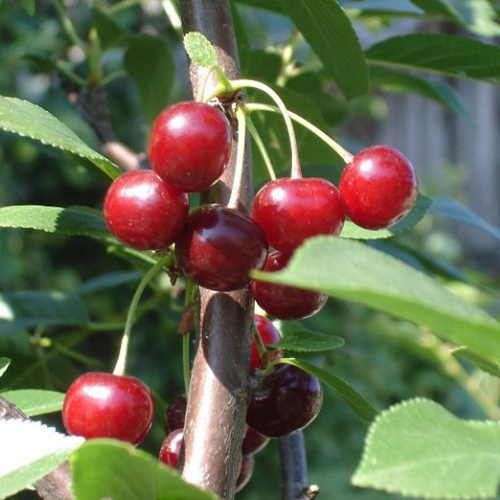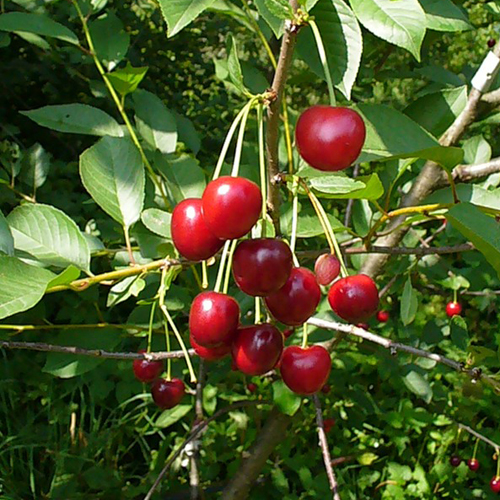Cherry variety Volochaevka
Due to the fact that in recent decades, cherries in Russian gardens have been tormented by moniliosis, many are abandoning this culture. But there are varieties that are much more hardy than their predecessors. Among them is Volochaevka. She was obtained from crossing Vladimirskaya and Lyubskoy at the Federal State Budgetary Scientific Institution "All-Russian Selection and Technological Institute of Horticulture and Nursery", the author - A.I. Evstratov. The application for admission of the "novelty" to cultivation was registered in 1986, and in 1997 the variety was included in the State Register of Plants of the Russian Federation for the Central Region (Kaluga, Bryansk, Ivanovskaya, Vladimirskaya, Ryazan, Tula, Smolensk, Moscow regions).

Description
The tree is small, usually grows up to 2 meters, but three-meter plants are no exception. The crown is spherical, moderately thickened, medium-leafy. Erect shoots, medium thick, brown bark. Cherry leaves are of normal size, obovate, dark green in color, with a serrated crenate edge. The surface of the leaf plate is smooth, matte, with reticulated veins. The petiole is ordinary, near the base of the leaf there are one or two small light-colored glands. The ovary at Volochaevka is formed on the bouquet twigs and growths of the last year.
Drupes are medium in size or larger, weighing 2.7 to 4.5 grams. The shape is oval or round, the skin is glossy, the color is dark red. The pulp is moderately firm, tender, juicy, dark red. The taste is dessert, sweet and sour, with sweetness prevailing. The aroma is delicate, cherry. Assessment of tasters 4.7 points. The juice is colored, dark red. By all indications, the variety belongs to the Griots or Morels. 100 grams of pulp contains: 15.6% dry matter, 10% sugar, 1.4% acid, 22 mg of vitamin C. The bone is ordinary, it is easily separated from the pulp.
Characteristics
- During the fruiting period, Volochaevka enters 4 - 5 years after planting, which fits into the usual terms for the culture as a whole;
- the yield of the variety is high. During the tests from 1992 to 1996, this figure was 66 c / ha, which is 25 c / ha higher than the results of Vladimirskaya, which was a control species. From one tree, from 10 to 15 kg of fruits are harvested, in the south - up to 20 kg;
- cherry ripening period is average. The fruits ripen by July 20 - 25;

- fruiting is stable, annually, the variety does not suffer from frequency;
- the plant is resistant to cold snaps, bad weather does not affect the yield level;
- frost resistance of Volochaevka is not bad, at the level of Vladimirskaya. It tolerates frosts well down to -30 ° С, but in a colder period, the kidneys may suffer;
- resistance to the most dangerous diseases in the variety is average. In rainy years, it can be affected by coccomycosis. Almost does not suffer from moniliosis;
- self-fertility in cherry is good, even if there is no pollinator nearby, the tree will not leave you without a crop;
- fruit transportability is average;
- the way of using drupes is universal. Delicious berries are good in their natural form, they are also suitable for processing and canning.
Planting and leaving
In the southern regions, seedlings of this variety are planted exclusively in autumn - in October. In cooler regions - in the spring, around April, before the buds begin to bloom. Before planting, acidic soils must be limed, and sand is added to heavy clay soils for greater looseness. During the growing season, cherry care is standard. Watering is carried out taking into account atmospheric precipitation, the soil in the trunk circle must be loosened and kept clean, destroying weeds. Obligatory procedures for Volochaevka are preventive treatment against diseases and pests, as well as insulation of the stem and root zone of a young plant in winter. If at the time of flowering frost unexpectedly returned, the best way out is to smoke.
Volochaevka is the most reliable among mid-season varieties of the Central region, which will always delight the gardener with tasty and large fruits.An unpretentious tree to care for has good frost resistance, for the sake of it you do not need to additionally plant pollinators, and its modest size will easily help you place cherries in any corner of the garden. The only drawback is the need for preventive treatments for fungal diseases. But this measure will help to avoid trouble.








